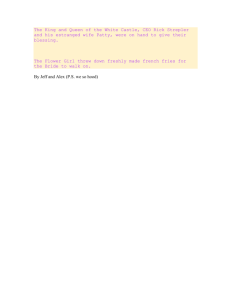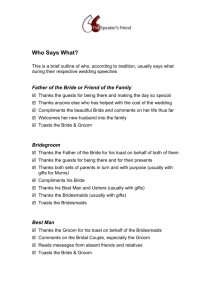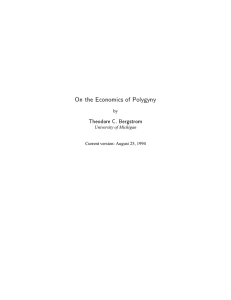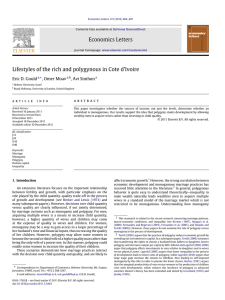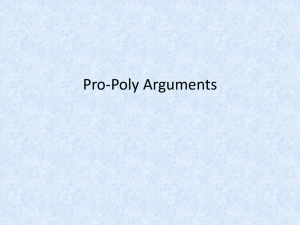polygyny
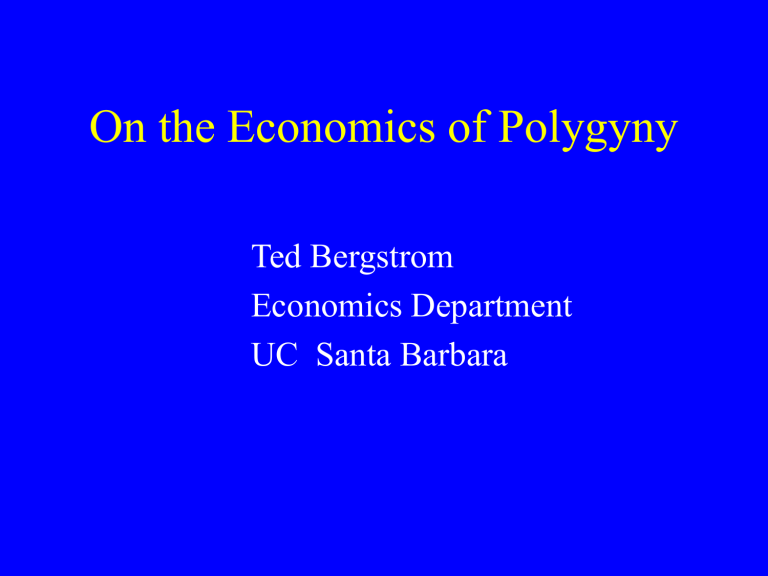
On the Economics of Polygyny
Ted Bergstrom
Economics Department
UC Santa Barbara
Poly Families
• Polygamy—Multiple mates of unspecified sex and number
• Polygyny---One man with many wives
• Polyandry---One woman with many husbands
• Polygynandry---More than one person of each sex
Murdoch’s Ethnographic Atlas
• 1170 recorded societies.
• 850 are polygynous.
• Polyandry is rare, but is found in Himalayan regions.
• In African countries, percentage of women living in polygynous households ranges from 25% to 55%.
Two questions:
• Why is polygyny common and polyandry rare?
• Why is bride price in Africa positive and not negative?
Proposed Answers
• Polygyny is more common than polyandry because of reproductive technology.
– People value reproduction.
– Sperm is abundant, wombs are scarce.
– A woman with a shared husband is about as fertile as with one or more husbands.
– A man’ s fertility increases sharply with number of wives.
Evolution of Sex ratios: Nature’s choice and efficient markets
• Why do most mammals produce about equal numbers of males as females.
• Wasteful Nash equilibrium, since one male can mate many females. (Waste less if males help raise offspring.)
• Darwin—Fisher equilibrium theory.
African polygyny and bride price
• In cattle-raising societies of Africa, polygyny is the norm.
• Most wealth is cattle. Men trade cattle for wives.
• Price is usually high, 20 or more cattle. Very significant fraction of individual wealth.
Two more questions, one answer
• Is a dowry a negative bride price?
• Why do many agricultural societies have dowries?
• Answer 1: No, bride price is paid to the bride’s male relatives by groom. Dowry is paid to the newly wed couple by bride’s relatives.
• Proposed Answer 2 comes later.
Trading Material
Wives for Cattle by Adam Kuper
• If a man had 3 wives, he would have 3 separate estates. Each estate had a right to the products of its gardens, the calves and milk of its cows, the earnings of the wife and her minor children, and the bridewealth received for its daughters. If the bridewealth for a daughter was used to acquire a wife for the son of another wife or to acquire another wife for the husband, then a debt was created.
A formal model
• Men’s utility U(x,k) : k is number of surviving children and x is own consumption.
• Production function for children nf( r): n is the number of wives, r is consumption goods given to wife and her children.
• Fertility function of a wife f( r)
Bride prices, gross and net
• Value of woman j’s labor: wj
• Bride price of woman j: bj
• Assume all women equally fertile, in equilibrium all have same net cost, p=bj-wj.
• Net cost of buying a woman and giving her r units of goods is p+r.
The efficient way to spend $Z on raising children
• Solve equation f(r *)=f’(r*)(r*+p) for r*
• Let n*=Z/(r*+p)
• Buy n* wives. Give each wife r* units of resources for herself and her children.
• You will then get n*f(r*)=Z f(r*)/(r*+p) children.
• Note constant returns per dollar. Price of a kid is f(r*)/(r*+p).
More about the solution
• In equilibrium, all wives are treated the same, whether they marry rich or poor man, and whether they are more or less productive as workers.
This simplifies pricing, parents don’t care who daughter marries. (In contrast to case of dowry.)
See Borger-Mulderhoff for empirical work on
Bride prices among Kipsigis.
The integer problem
• Wives come in indivisible units. Possible ways of dealing with this nuisance.
• Lottery solution.
– To buy 1/10 of an expected wife, bet p/10 at odds 10 to
1. If you win, you get p which you spend on an additional wife. If you lose, you add no wife.
• Time-sharing
– Polyandry
– Urban Underclass model. W.J. Wilson, R. Willis
Comparative statics
• Rogers’ Law –
The more you have to pay for a bride, the better you will treat her .
• This is a comparison across equilibria. For proof, see diagram.
• Normal goods theorem-
Demand curve for wives slopes down if demand curve for kids slopes down .
General Equilibrium Question
• What determines price?
• Where does wealth to pay for brides come from?
Does need to purchase brides reduce other productive investment?
Wealth comes from the sale of sisters.
Bride price is both source of income and of
Expenditure—cancels out on average. Just a matter of moving existing cows around.
Time for transparency
Concord at the Campfire
• Suppose that Alice and Bob real concern is only for the size of the fire.
• Each values berries only as an instrument to giving them strength to build the fire bigger.
• Then both agree on the amount of berries each should pick and the amount of firewood each should gather.
No Bargaining Needed
• Alice specializes in wood-gathering and
Bob gathers berries.
• Bob gives Alice berries to keep up her strength for wood-gathering.
• Alice and Bob agree perfectly on how much berries Alice should pick and how much she should give Bob.
Monogamy and Domestic
Harmony
• Are monogamous couples of fitness maximizers like Alice and Bob the fire maximizers?
• If the only children that either will have are by the other, then whatever actions increase the number of descendants of one increase the number of descendants of the other.
• Environment for selfless love?
The In-law Problem
• Even in the Eden of perfect monogamy, the snake of conflict can be found.
• Hamilton’s kin selection theory. Each spouse values his or her siblings and other relatives, but the sibling of one is unrelated to the other.
• Hence inclusive fitness functions conflict
• Conflict returns, though muted.
More trouble in Eden
• High death rates of people of fertile age
• Remarriages of widows and widowers likely
• And adultery…
• Philandering and cuckoldry. (Hawkes,
Rogers, and Charnov—the male’s dilemma
Conflict of interest
• Children by previous marriage don’t get good care from non-related spouse
• Daly and Wilson Homicide
• Evidence of bad outcomes for children without resident biological father (Comanor and Phillips, Kelly Bedard and Heather
Antecol)
Physical evidence of mating history—Comparing primates
• Correlation across species between size difference of sexes and degree of polygyny
• Claim—in polygynous species there is a bigger return to males fighting other males.
Size advantage yields more mates
• Examples:gorillas and orangs—gibbons— chimps and bonobos
Whose are bigger?
• Chimps are highly promiscuous and sexes differ by only about 6%
• Gorillas are not promiscuous, (though polygynous). Females stay with same male
• The testes test
Gorillas, chimps, humans?
So where do humans place?
• By these physical tests, humans come out as moderately promiscuous and moderately polygynous
• In accord with what is known about modern hunter-gatherers
Conflict over Birth Intervals?
• Argument—Children are much more expensive to women than to men. Therefore we should expect women to want fewer children than their husbands do
• Hold on—What about Alice and Bob the fire-builders? Won’t monogamists want the same thing?
• Difference in interests arise with inlaw problem, early death of one spouse, adultery and rape.
• What are these differences?
• Differential values of previous children relative to new one.
• Differential values of potential future children relative to present new one
• Fidelity threshold and contributions to man’s sister’s children
• Battle between mother and fetus for resources is a battle between father’s genes and mothers—David Haig
• With high cuckoldry probabilities, men will tend to want shorter birth intervals than their wives
A partial explanation for reduced birth rates?
• Tug-of-war model between sexes over birth rates. Each sets a target beyond its preferred point.
• As women’s social power rises, so does their influence in household decisions.
Competing Theory
• Becker et al attempt to explain demographic transition by relative prices
• But this doesn’t account well for the fact that with large increases in income, number of children diminish. Are they inferior goods? Wouldn’t evolutionary theory suggest that they are normal goods?
Leverage in Tug-of-War
• Perhaps the major explanator of changes in birth rates is not changes in prices and incomes faced by a single rational decisionmaker
• But rather a shift in bargaining power from those who favor higher birth rates to those who favor lower birth rates.
Help
-
Help
Don’t Help
B-C B
